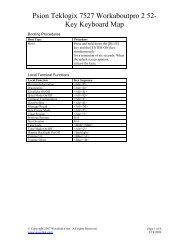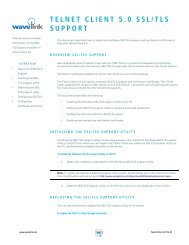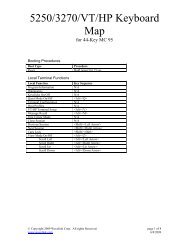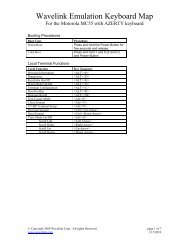Avalanche Remote Control User Guide - Wavelink
Avalanche Remote Control User Guide - Wavelink
Avalanche Remote Control User Guide - Wavelink
Create successful ePaper yourself
Turn your PDF publications into a flip-book with our unique Google optimized e-Paper software.
Chapter 6: Configuring Server Settings 39Chapter 6:Configuring Server SettingsThe <strong>Remote</strong> <strong>Control</strong> Server facilitates connections with mobile devices. You canconfigure the settings for the server in the Server Settings tab. These settings aredeployed to the mobile device when the package is downloaded. From the ServerSettings tab, you can perform the following tasks:• Configuring Server Connection Settings• Configuring SMS Options• Ports List• Changing Server Information• Configuring Database and License Server AccessConfiguring Server Connection SettingsYou can configure the following settings from the Server Settings tab in the <strong>Remote</strong><strong>Control</strong> Console:• Server Address. This is the address of the <strong>Remote</strong> <strong>Control</strong> Server visible to yourinternal network.• Server Port. Connections between <strong>Remote</strong> <strong>Control</strong> and your device use this port. Ifconnections are made via port forwarding, your administrator must forwardtraffic for this port to the server. If this port changes, you must restart your server.• Server ID. This is a pre‐shared key that is used between the <strong>Remote</strong> <strong>Control</strong> Serverand <strong>Remote</strong> <strong>Control</strong> client. When a wide area connection request is made, the keyis sent to the client. Using this pre‐shared key, the client can determine the correctIP address with which to connect.• WAN Address. This address is dependent on the type of connection your clientsuse to connect to the server through a wide area connection.• If your clients connect through a VPN connection, this is the internal address ofthe server which is visible to VPN connections.• If your clients connect through port forwarding, this is the externally visible IPaddress.
















